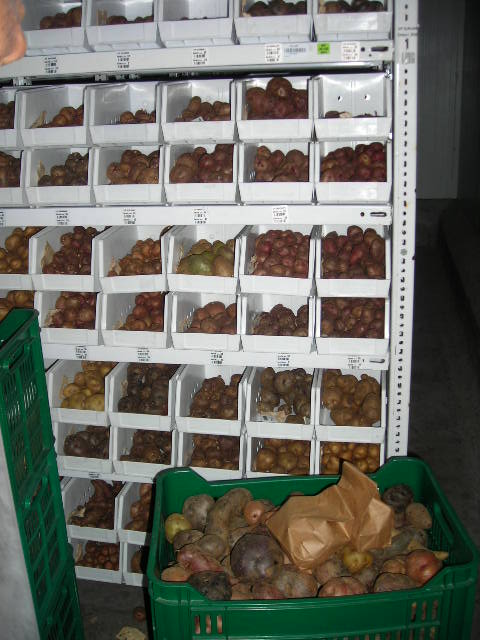Vegetative bank
Contributors to this section: ILRI, Ethiopia (Jean Hanson); Bioversity International/ILRI, Ethiopia (Alexandra Jorge).
Storing plant propagules using cold storage
Vegetative propagules of several tuber crops, including potato, sweet potato, yam and cassava can be conserved under cold conditions of 4-20°C for several months between one harvest and the next planting season. Cold storage avoids deterioration following the harvesting of fresh tubers or stem cuttings and consequent losses caused by both physiological changes within the plant by reducing respiration and infection by pathogens and pests during storage.
Pretreatment
Storage propagules should be free of damage caused by insects and nematodes and any other visible symptoms of diseases before storage. Any type of wounds, scraping and peeling can affect the storage life of vegetative material by allowing fungi and bacteria to enter the plant and causing rotting. The storage propagules should be disinfected as soon as possible after harvest using either a 5% sodium hypochlorite solution or an insecticide and fungicide solution and soaking the propagules inside mesh sacks or storage containers for 10 minutes.
|
|
Storage
The propagules selected for storage are usually stored in mesh sacks, or open boxes made of wood, or plastic to allow air circulation with duplicated labels with the identification number, both inside and outside the container. Stems are often more robust and can be stored in bundles or in polythene bags with the cut ends covered with wax to prevent excessive drying during storage. The material should be monitored weekly for signs of rotting, insect damage or rodent damage.
Reported methods for storage include:
Sweet potato storage tubers may be cured by placing them in a high temperature chamber (25-30ºC) with a high relative humidity (RH) (85-90%) for 4-7 days in order to heal all wounds and then stored under a controlled temperature of 12ºC and a high relative humidity for up to 7 months.
Potato tubers are usually stored at temperatures from 2 to 14 ºC and a relative humidity around 70% in the dark for up to 6 months.
Cassava stems with viable buds can be stored at 20–23ºC and 70–80% RH in bundles or in polythene bags in drier areas during the dry season.
Yam storage tubers should be allowed to dry in the shade for 4 to 6 weeks and can then stored at 18–20°C in a dry cool area for 3 to 4 months. Chilling damage occurs when tubers are stored below 10°C.
References and further reading
Dumet D, Adeyemi A, Ojuederie O. Cassava in vitro processing and gene banking. IITA, Nigeria. Available from: http://www.iita.org/cms/articlefiles/515-genebank_Cassava_manual.pdf. Date accessed: 24 March 2010.
FAO. 2013. Genebank standards for plant genetic resources for food and agriculture. Food and Agriculture Organization of the United Nations, Rome. Available in English, Spanish, French, Arabic, Russian and Chinese here.
Kushman LJ, Wright FS. 1969. Sweetpotato storage. Agricultural Handbook N° 358. USDA, Washington, D.C.
Huamán Z. Clonal Sweetpotato germplasm management training manual. Section 2.1 Maintenance of sweetpotato germplasm in field genebanks. CIP, Peru. Available from: http://www.cipotato.org/csd/materials/Sweetpotato/Batsect2.1.pdf. Date accessed: 24 March 2010.
Comments
- No comments found






Leave your comments
Post comment as a guest